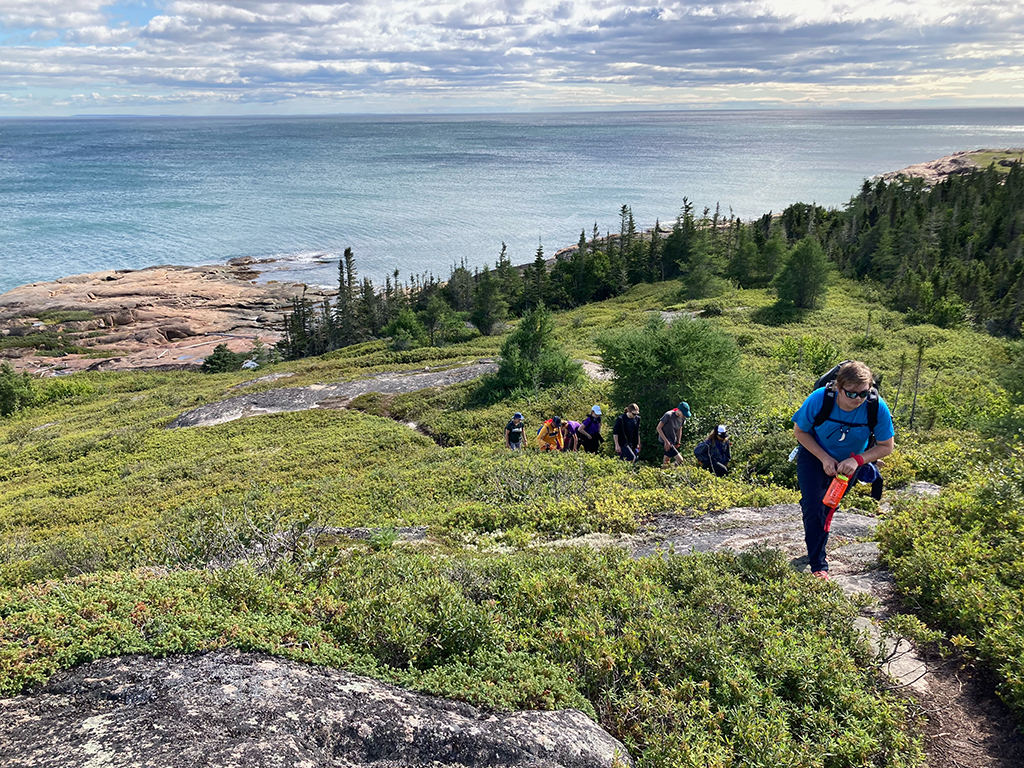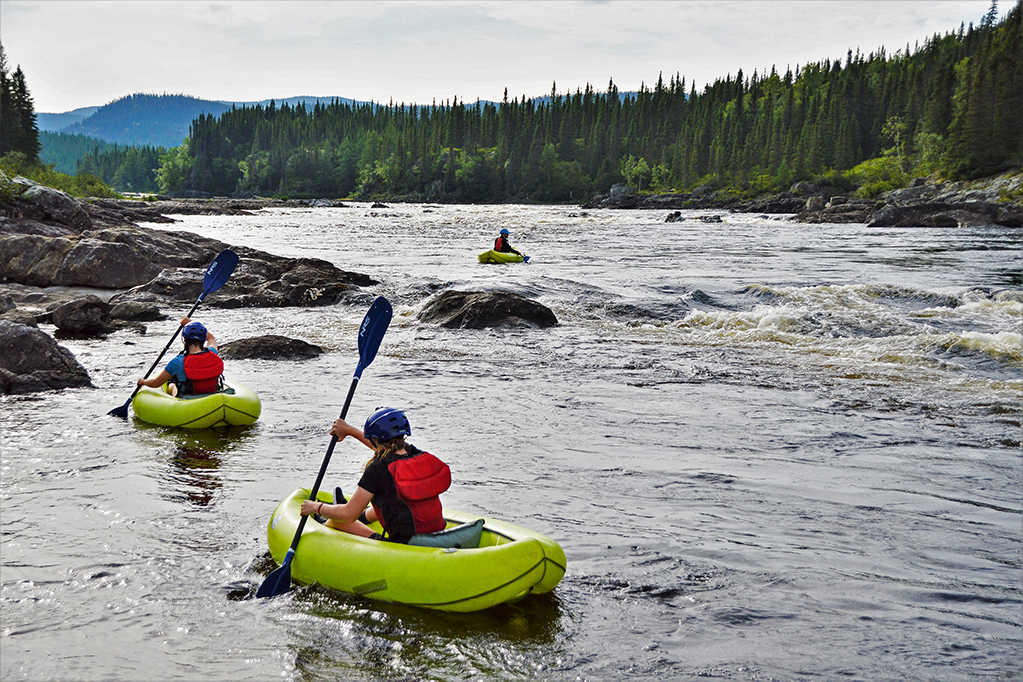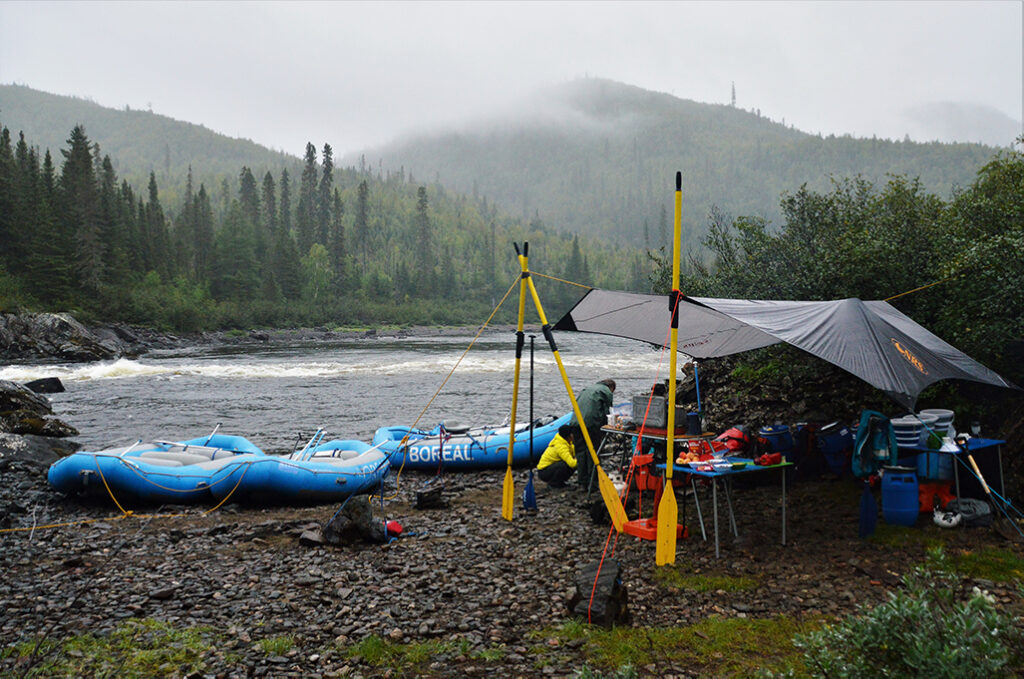Becoming the river: a journey down the Muteshekau Shipu (Magpie River)
A group from Bishop’s College School finds joy – and mud – at the water’s edge
Author: Jennifer Kingsley

Bishop’s College School group on the Muteshekau Shipu. Standing: Caleb Aubut, Evan Jones, Emma Andrews, Yan Goyette (guide), Krysten Lamb Chaimber Condo, Liam Condo Sitting: Luis Cao, Barbara Rowell, Emma Hopkins, Maeve MacLachlan, Jess Zajko (guide).
Eight students. Two teachers. Fourteen hours. One van.
It was a long trek for the paddlers from Bishop’s College School, in Sherbrooke, Québec, to reach Magpie Village on the North Shore of the St. Lawrence. They were happy to see that their guides, Yan Goyette, Maxime Girard, and Jessica Zajko, had already set up the tents.

Hiking the north shore of the St. Lawrence before flying in to begin the river trip.
After a night’s sleep, the group met Lydia Mestokosho-Paradis and her aunt Rita Mestokosho, who are both Innu from the community of Ekuanitshit. They conducted a ceremony to prepare the student group for eight days on the Muteshekau Shipu (Magpie River), including gifts of red bracelets and bandanas to protect them.
“The Magpie River is everything for us,” Lydia told Global News earlier this year, and the send off she prepared helped the students to understand that.
Teacher Krysten Lamb remembers how important that idea became as they paddled the river’s clear water. “One thing they mentioned,” said Krysten, “Is that every three to five days all of the water in your body is replaced. You actually become the river.”
For this group, becoming the river meant throwing themselves into everything, including the river itself. “This was the first time I had people asking if they could float down the river,” said guide Yan Goyette, who has paddled the Magpie nine times. “They loved the water.”

Kayarafts are easy to inflate en route and give people a chance to paddle on their own.
The students involved were chosen by their teachers, Barbara Rowell and Krysten Lamb, who applied for funding through the school’s Ondaatje Endeavour, which has supported annual adventures for students in several countries. This time, they stayed in Canada to visit what paddlers widely recognize as an ideal waterway for rafting.
The rapids are nearly continuous in many sections, which makes it a wonderful setting to learn new skills on the water, something that all of the students grew to love. But the learning was not limited to their paddling time.
Take Luis Cao, who is in grade 10 this year. Everything from fishing to camp cooking was new to Luis on this trip, and he wanted to learn it all. “Anything anybody was doing,” Krysten said, “He would say, ‘Can I try that?’ You didn’t have to ask him. He would ask you.”

Luis Cao (centre) has asked for fishing gear for his birthday.
“He was mostly quiet and listening at the beginning,” said Yan, “and by the end he was more involved and making jokes. That’s what rivers can do.”
By the end of the week—after days of rain according to the teachers and “pretty good weather” according to their guides—the students didn’t hesitate to pull the rafts through mud that came up to their knees and even sucked their shoes right off.
“Everyone was in a positive mood,” Barbara said. “It was lots of fun in the end.”

Nothing beats the weather like a solid tarp set up.
The fun that comes with ecotourism may have an important role to play in the river’s future. Indigenous and non-Indigenous governments in this region came together to make the Muteshekau Shipu (Magpie River) the first ecosystem in Canada to be granted the same legal rights as a person. Hopefully this landmark decision will let the water flow free and clear forever.
Though we are striving to be as accurate and respectful as possible in our use of Traditional names of places and Peoples, we recognize that we are bound to make mistakes. Please reach out to us anytime – we welcome the opportunity to listen, to learn, and to connect with you. info@borealriver.com
Links:
Read: 3 common myths about rafting trips
Read: What my raft guide is thinking at the top of a rapid

